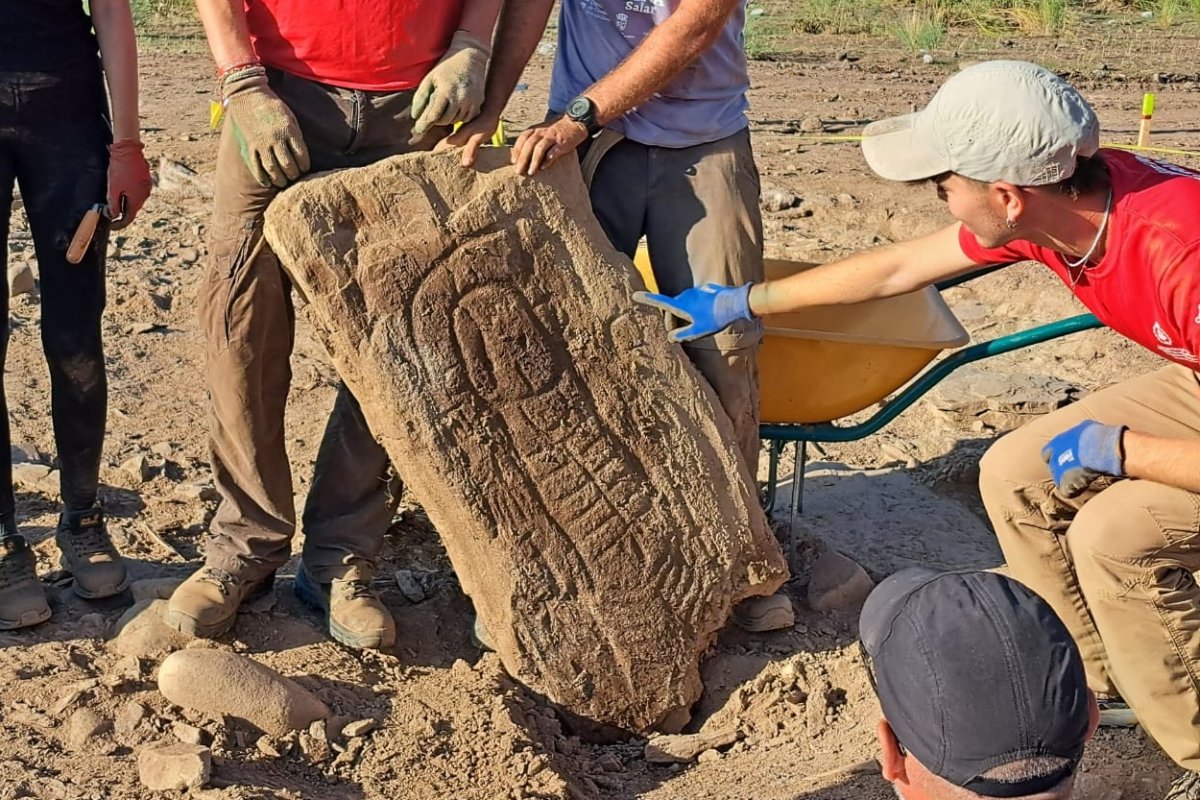An "exceptional" prehistoric monument has been discovered by archaeologists at an almost 3,000-year-old funerary complex.
The ancient decorated stone monument, known as a stela, was unearthed in the necropolis of Las Capellanías, which is in the town of Cañaveral de León in southwestern Spain.
The mysterious find is "very rare" and "changes long-held ideas about the nature of social elites in southwest Europe around 3,000 years ago, as well as the role and nature of these distinctive commemorative monuments," Marta Díaz-Guardamino, one of the archaeologists involved in the discovery, told Newsweek.
Stelae are carefully shaped stone slabs, made to be set vertically, that feature decorations or inscriptions on one of their faces.

Archaeologists have documented various traditions of decorated stelae across the world over different time periods.
To date, around 300 of these artifacts, and similar monuments known as statue-menhirs, have been found across the Iberian Peninsula. This stretch of land, which forms the southwestern part of Europe, is today primarily divided between Spain and Portugal.
In the period 1250 to 700 B.C., the decoration of stelae in prehistoric Iberia was focused on representations of people that appear to have been relatively standardized. This is the period in which Las Capellanías was built, one that spanned the transition from the Late Bronze Age and early Iron Age in this particular region.
It is thought that Iberian stelae in this period "were monuments made to commemorate important personages of the community," said Díaz-Guardamino, who is with Durham University in the U.K.
Until now, archaeologists had identified two main types of figures represented on Iberian stelae from this period. The first is the "warrior" figure, which was thought to depict male individuals because it featured weaponry even though only a small handful displayed male bodily traits.
The other type involves figures with headdresses, very often featuring depictions of necklaces. They were typically interpreted to be female individuals even though only a handful included representations of female physical traits.
But despite a long history of research starting more than 120 years ago, very little is known about the use contexts for prehistoric stelae and statue-menhirs in Iberia.
"Overall, the meaning and function of Iberia stelae and statue-menhirs have been very difficult to discern and hotly debated among archaeologists," Díaz-Guardamino said.
The latest stela to be uncovered in the region was found by Díaz-Guardamino's team at Las Capellanías in September. It was lying on top of a circular cremation structure that it apparently was associated with. It is the third stela to be discovered at the site—the first was found in 2018 during work to fix a rural path that is now known to cross the necropolis.
Díaz-Guardamino and her colleagues started fieldwork at the site last year to check whether this first stela came from the site or had been brought in from elsewhere. It was this work that demonstrated the presence of a funerary complex at the site and showed that the original stela most likely came from there. The team subsequently found a second stela at the site.
The fact that the third stela was found "in context in a funerary site where two other stelae had been found is unique and exceptional," Díaz-Guardamino said. "The contexts of use of these monuments are totally unknown, so this is the first time that we have a context to interpret how these very rare monuments were used and their significance among Late Bronze Age and Early Iron Age society."
In addition to being found in context, the artwork on the stela brings into question traditional interpretations of the two main types of figures ("warrior" and "headdress") typically found on such monuments from this period in Iberian history, according to Díaz-Guardamino.
"The stela depicts a human figure with a headdress, a necklace and two swords," she said. "The figure also has a detailed face, hands and feet, as well as male genitals. Thus, the stela combines traits of both headdress and warrior types. As the new stela also includes male genitalia, it demonstrates that these social roles were not restricted to a specific gender but could be associated with different genders."
She continued: "This stela shows that these previous interpretations were simplistic and reflected more our own modern conceptions of gender than the ones of prehistoric societies."
Decorated stelae dated to the period 1250 to 700 B.C. are already rare artifacts in Europe, according to Díaz-Guardamino. But the latest find is even more remarkable in that it represents the first time a stela combining the traits of the warrior and headdress figures has been found—not to mention the fact that it was found in its original context.
Researchers think the necropolis was used from around the 9th century to the 6th century B.C., but this needs to be confirmed with radiocarbon dating techniques.
"The necropolis has yielded several graves that contained human cremations and a range of very special grave goods," Díaz-Guardamino said. "This evidence is currently being analyzed, and we hope it will produce detailed information about the temporality of the necropolis, the provenance of the materials and the people buried in it."
Determining the age of stelae is a particularly challenging task because rock carvings cannot be dated scientifically, not to mention that these monuments may have been used multiple times.
However, different lines of evidence—including the nature of the decorations and, importantly, the context—suggest that the latest stela to be discovered at Las Capellanías was made and used sometime between the ninth and seventh centuries B.C. This date is preliminary and subject to change in light of the results of radiocarbon dating efforts at the site.
Uncommon Knowledge
Newsweek is committed to challenging conventional wisdom and finding connections in the search for common ground.
Newsweek is committed to challenging conventional wisdom and finding connections in the search for common ground.
About the writer
Aristos is a Newsweek science reporter with the London, U.K., bureau. He reports on science and health topics, including; animal, ... Read more
To read how Newsweek uses AI as a newsroom tool, Click here.








